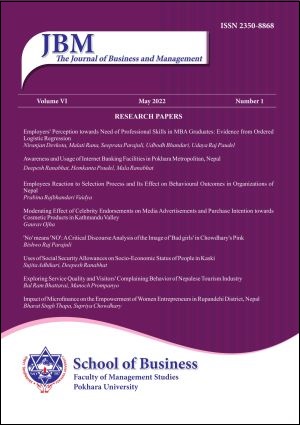‘No’ means ‘NO’: A Critical Discourse Analysis of the Image of ‘Bad girls’ in Chowdhary’s Pink
DOI:
https://doi.org/10.3126/jbm.v6i01.46636Keywords:
Critical discourse analysis (CDA), good/bad girl image, male chauvinism, violence against womenAbstract
Background: The ongoing discourse about the agency and asserting the dignity of women’s body is a prime concern for artists and activists. Their works raise tough questions about gender issues especially in metro cities. The selected movie Pink is a representative work that deals with sexual assault upon women, a burning issue under a socio-judicial discourse of our time.
Objectives: This study analyses a case of violence again women in the Bollywood movie Pink (2016) from the point of view of Critical Discourse Analysis (CDA). From social perspectives, the movie also reveals tendency of victim blaming, the prevailing social norms, especially in the Indian subcontinent, about the image making of so called ‘good girls’ or ‘bad girls’.
Methods: The paper primarily used Siegfred Jager’s model of CDA as a conceptual framework of primary text analysis. However, the study also incorporated other theoretical outlooks as per the need and relevance of research objectives. For examples, the views of Susan Bordo, Simone de Beauvoir, Colette Guillaumin (especially the concept of appropriation) and Judith Butler (especially the concept of body performativity) etc. guided the discussion. Jager’s Dispositive Model of CDA offers a pragmatic approach to discuss the disparity between constructed knowledge and actions. It looks at social texts triangulating three aspects: discursive, non-discursive and materializations or manifestations of first two aspects.
Results: The analysis revealed some striking influences in the socio-judicial system of judging cases of VAW. In the illustration part, the interrelated strands of discussion have been clustered thematically as Strand 1: Dos and don’ts for girls, Strand 2: Sex appeals of girls, Strand 3: ‘Good girls’ in the eyes of a male chauvinist, Strand 4: Virginity matters for men, and Strand 5: ‘No’ means ‘NO!’ These five strands of discussion and their legal implications work as the key trope in bringing the case hearing to a logical conclusion. Taking account of the issues, the lawyer, who is advocating for the victims, brings his advocacy to a cogent conclusion.
Conclusion: The final verdict of the court addresses the filed complaints of gender violence against the girls. The perpetrator is found guilty for attacking and outraging a woman’s dignity and agency of her body. However, the dispositive or settling aspect of discourse on gender violence is still on the process. Similarly, the discursive and non-discursive behaviors of both the perpetrator and the victims have not come to the surface. This provides ample of space of further inquiry and contestation in the research problem.
Downloads
Downloads
Published
How to Cite
Issue
Section
License
Copyright © the School of Business. All rights reserved. No part of this volume may be reproduced or utilized in any form or by any means, electronic or mechanical, including photocopying, recording, or by and information storage and retrieval system, without permission in writing from the publisher.




